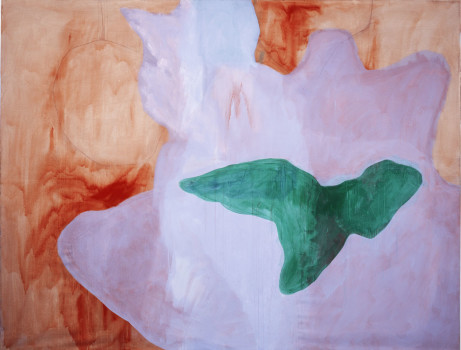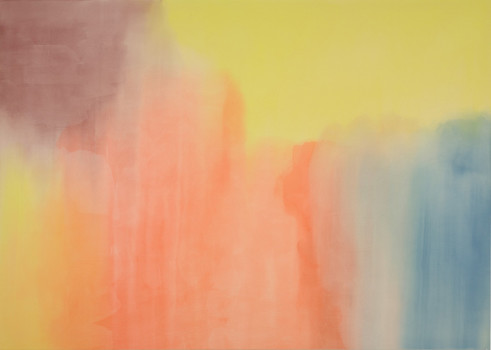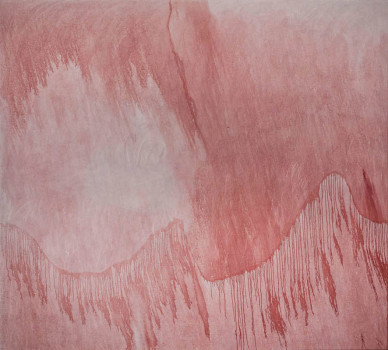Gallery exhibition
more about
The number of paintings in this presentation derives from the number of rooms that the exhibition space of Galerie Isabella Czarnowska is divided to.The organizing principle of this presentationis to display only one painting in each room. By separating the paintings between the different rooms of the gallery, the presentation reflects on a basic quality of Markus Döbeli’s painting practice – that of absolute singularity, irregularity, and irreplaceability.The painterly act of Döbeli is alienated to notions such as style or ar tistic signature. Neither a projection of an idea, nor a procedure, Döbeli’s painting undermines both the model of subjective handwriting, and the model of systematized production. A painting by Döbeli is like an event – discontinuous, unformattable, unique; it is an isolated experience of time and space.
Even though it obeys the categorical imperatives of Modernist painterly abstraction – anti-illusionism, flatness, the lack of compositional hierarchy – Döbeli’s practice cannot be labelled as ‘Modernism Revisited’, ‘Reinventing Abstraction’, or ‘The Return to Painting’. It is neither critique nor homage, neither deconstruction nor nostalgia.
Döbeli’s painting is a sor t of phase transition, a performance of an indeterminate state of matter.It explores the chemical proper ties of paint as a constant shift between all states of matter.The streams of paint that flood the surface of the canvas manifest liquidity; the expansive movement of paint from and through the canvas signifies a process of evaporation, and the absorption of paint into the fabric of the canvas demonstrates congealment.The ways in which paint is distributed in Döbeli’s paintings can be described as screening, veiling, injecting, crumbling, pouring, flooding, sweeping and blowing. Each mode of distribution determines different material/textural and spatial/topographical effects.
Commonly referred to as ‘the red one’, Painting, 1999, Acr ylic on Canvas, 320 x 355 cm, the first painting in this presentation, exemplifies Döbeli’s approach to paint.The red trickles in the bottom and the upper left par t of the painting belong to the realm of liquidity, but at the same time they are like threads, and in this sense they also expose the threads that comprise the canvas fabric on which they were painted, and represent the filaments of the brush with which they were painted.Yet, while dealing with the chemical proper ty of the paint, and the material suppor t of the painting, Painting, 1999, also unravels the canvas fabric, exposing its threads not as par ts of an interlaced networks, but as single unwoven elements.
In addition, Döbeli’s painting explores the optical proper ties of paint as light and color.The chromatic radiance of his paintings is the immaterial aspect, the other side of their indeterminate state of matter.
Simultaneously uniting and disuniting the optical and the chemical, each painting moves back and for th between sublimation and de-sublimation, color and material, uprooted vision and grounded physicality.
Die Anzahl der Bilder in der Ausstellung ergibt sich aus der Anzahl von Räumen der Galerie Isabella Czarnowska: In jedem Raum wird jeweils genau ein Bild gezeigt. In dieser Aufteilung der Bilder auf die verschiedenen Galerieräume spiegelt sich die maßgebliche Eigenschaft der Malerei von Markus Döbeli wider, für den sie einen singulären, keiner Regel gehorchenden und durch nichts zu ersetzenden Akt darstellt. Seinem Schaffen sind Vorstellungen wie die eines Stils oder einer malerischen Signatur fremd. Es beruht weder auf einer individuellen Idee noch auf einem spezifischen Malprozess und unterläuft auf diese Weise das Modell einer subjektiven Handschrift einerseits, das einer systematisch-methodischen Produktion andererseits. Seine Bilder gleichen Ereignissen; sie sind diskontinuierlich, nicht festzulegen, einmalig und eröffnen eine räumliche und zeitliche Erfahrung ganz eigener Art.
Auch wenn sich Döbelis Malerei den kategorischen Vorgaben der abstrakten Malerei unterzuordnen scheint – ihrem Antiillusionismus, ihrer Flächigkeit, ihrem Verzicht auf eine hierarchische Komposition – lässt sie sich keineswegs mit einem Label wie „Revision der Moderne“, „Neue Abstraktion“ oder „Rückkehr zur Malerei“ fassen. Seine Bilder sind weder Kritik noch Hommage, weder Dekonstruktion noch nostalgische Reminiszenz.
Döbelis Malerei stellt eine Ar t Phasenübergang dar und konfrontier t uns mit einer unbestimmten stofflichen Zustandsform. In seinen Bildern erkundet er den beständigen Wandel des chemischen Aggregatzustands der Farbe. Mal fließt sie, so etwa in den Farbströmen, die sich über die Oberfläche der Leinwand ergießen, mal scheint sie zu verdampfen, wenn sie von der Leinwand in den Raum hinein abstrahlt, und dann wieder zu erstarren, indem sie in das Leinwandgewebe eindringt. Dabei bedient sich Döbeli bei seinen Bildern ganz verschiedener Formen des Farbauftrags, ob deckend, wie ein Schleier oder zerbrechlich; die Farbe wird geschüttet oder gestrichen, sie verweht auf der Leinwand oder flutet sie, was zu jeweils ganz eigenen strukturellen und topografischen Effekten führt.
Beispielhaft lässt sich Döbelis Farbbehandlung an dem Gemälde Painting, 1999, Acr ylic on Canvas, 320 × 350 cm erkennen, dem ersten Bild der Ausstellung, das meist als „Das Rote“ bezeichnet wird. Die roten Farbschlieren in der unteren Hälfte des Gemäldes sowie links oben verweisen auf die Sphäre des Flüssigen, zugleich jedoch erinnern sie an lose Saumfäden und lassen somit an die Fädchen des Leinwandgewebes und die Haare des Pinsels denken, mit dem das Bild gemalt wurde. Im Mittelpunkt von Painting, 1999 stehen nicht allein die chemische Beschaffenheit der Farbe und der materielle Maluntergrund, vielmehr wird das feste Gewebe der Leinwand aufgetrennt und die Fäden erscheinen herausgelöst aus ihrem Gefüge als einzelne ungebundene Elemente.
Nicht zuletzt zeichnet die Malerei von Markus Döbeli aus, wie er die optischen Qualitäten von Licht und Farbe ausreizt. Die chromatische Strahlkraft seiner Gemälde verleiht ihnen etwas Immaterielles, was auch mit ihrem unbestimmten Aggregatzustand zusammenhängt. Die Bilder oszillieren zwischen Sublimierung und Entsublimierung, Farbe und Material, schwereloser Bildkraft und erdverhafteter Körperlichkeit.
Liczba obrazów na wystawie odnosi się do ilości pomieszczeń, na które podzielona jest przestrzeń galerii Isabelli Czarnowskiej. Zasadą przyjętą na tej wystawie jest prezentowanie po jednym płótnie w każdym z pomieszczeń. Zabieg wyizolowania poszczególnych prac i umieszczenia ich w oddzielnych przestrzeniach galerii odzwierciedla podstawową jakość malarskiej praktyki absolutnej jednostkowości, niezwykłości i niepowtarzalności każdego dzieła. Akt twórczy Markusa Döbeli’ego wyklucza stosowanie się do jakiegoś jednego stylu, czy malarskiej ecriture. W jego malarstwie nie chodzi ani o projekcje idei ani o ekspozycję procesu twórczego; wykracza ono zarówno poza model opar ty na osobistym „charakterze pisma”, jak zasadę systematycznej produkcji. Obraz Döbeli’ego jest jak zdarzenie – nieciągłe, niesformatowane, niepowtarzalne; jest wyizolowanym doświadczaniem czasu i przestrzeni.
Aczkolwiek twórczość Döbeli’ego podąża za imperatywem kategorycznym modernistycznej abstrakcji malarskiej, którego cechą jest nieiluzyjność, płaskość i niehierarchiczność kompozycji – nie można jej opatrzyć etykietą „zrewidowanego modernizmu”, „abstrakcji ponownie odkrytej” czy „powrotu do malarstwa”. Nie jest ona ani krytyką, ani hołdem, nie stanowi dekonstrukcji, ale też nie jest wyrazem nostalgii.
Malarstwo Döbeli’ego jest rodzajem stadium przejściowego, aktem niedookreślonego stanu materii. Penetruje ono chemiczne właściwości farby jako substancji ustawicznie zmieniającej swoje właściwości. Strumień farby, który zalewa powierzchnię płótna manifestuje płynność; jej ekspansywny ruch na powierzchni płótna oznacza proces ulatniania się a jej wsiąkanie w tkaninę podobrazia prezentuje przebieg krzepnięcia.
Sposoby rozprowadzania farby na obrazach tego malarza można określić jako wyświetlanie, przesłanianie, wstrzykiwanie, spulchnianie, rozlewanie, zalewanie, rozprzestrzenianie i rozdmuchiwanie. Każdy sposób determinuje inny efekt, zarówno materialno/fakturowy, jak i przestrzenno/topograficzny.
Już pierwsza na tej wystawie praca Painting, 1999, 320 x 355 cm, potocznie określana jako „czerwona”, ilustruje podejście Döbeli’ego do malarskiego tworzywa. Czerwone strugi u dołu i w lewej górnej części obrazu przynależą do sfer y płynności, lecz zarazem przypominają one coś w rodzaju włókien, i w tym sensie eksponują tkacki wątek płótna, na którym zostały namalowane, a jednocześnie ujawniają ślady duktu pędzla, dzięki któremu zostały stworzone.
Traktując o chemicznych właściwościach farby oraz o materialnym ugruntowaniu obrazu, Painting, 1999 odsłania także strukturę płótna, ukazując jego włókna nie jako część systemu splotu ale jako pojedyncze nieutkane elementy.
Dodatkowo, malarstwo Döbeli’ego bada optyczne właściwości farby: światła i koloru. Barwna promienistość jego obrazów to ich aspekt niematerialny, inna strona niedookreślonego stanu materii. Ustawicznie łącząc i rozdzielając optyczność i chemiczność, każdy obraz porusza się pomiędzy sublimacją a resublimacją, kolorem i materiałem, całkowicie zmienną wizją a ugruntowaną fizycznością.


